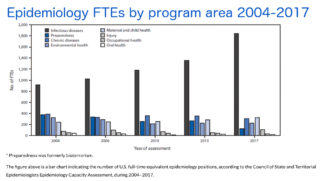States and territories have been steadily building their epidemiology staffs, but they collectively need another 1,200 to reach “full capacity” in terms of several key health areas, including foodborne illnesses and other infectious diseases.
One hundred percent of U.S. states and territories, as well as the District of Columbia, provided data supporting that estimate in the sixth periodic Epidemiology Capacity Assessment conducted by the Council of State and Territorial Epidemiologists. The council has reported a 100 percent participation rate since it began the surveys in 2004.

“From 2013 to 2017, the number of state health department epidemiologists increased 22 percent, from 2,752 to 3,369, the greatest number of workers since the first full Epidemiology Capacity Assessment enumeration in 2004,” according to a research report in the Morbidity and Mortality Weekly Report, which is published by the Centers for Disease Control and Prevention.
“… Overall, the 2017 Epidemiology Capacity Assessment documented that, although the epidemiology workforce continues to grow, there is an ongoing unmet need for additional epidemiologist positions in well-established areas, such as infectious diseases…”
The periodic survey evaluates trends in workforce size, funding, and epidemiology capacity among state health departments. Survey organizers sent a standardized web-based questionnaire to the state epidemiologist in the 50 states, the District of Columbia, the U.S. territories, and the Federated States of Micronesia. It included questions about:
- The number of current and optimal epidemiologist positions;
- Sources of epidemiology activity and personnel funding; and
- Each department’s self-perceived capacity to lead activities, provide subject matter expertise, and obtain and manage resources for the four Essential Public Health Services (EPHS) most closely linked to epidemiology.
Data on the health departments’ activities showed more than half of the epidemiology positions work in infectious disease program areas. The epidemiologists in the 1,838 infectious disease positions represent 55 percent of the total 3,369 full-time equivalents reported by government officials. The size of the epidemiology workforce in each state ranged from five to 208.
The 36 percent increase in epidemiology positions is necessary to meet basic service levels, according to the research report, but even more disease detectives are needed for other important work.
“Additional resources might be needed to ensure that state health department epidemiologists possess the specialized skills to deliver EPHS, particularly in evaluation and applied epidemiologic research,” according to the report.
Data collection for the report began April 28, 2017, and was completed Aug.11, 2017. Virtual technical assistance was provided to support completion of the project. The council conducted five previous Epidemiology Capacity Assessments in 2001, 2004, 2006, 2009, and 2013, with a supplementary workforce enumeration conducted in 2010.
What is epidemiology?
The scientific, systematic, and data-driven study of the frequency, pattern, causes, and risk factors of health-related states and events — not just diseases — in specified populations such as neighborhoods, schools, attendees of events, and victims of foodborne illness outbreaks. It is also the application of this study to the control of health problems.
(To sign up for a free subscription to Food Safety News, click here.)

